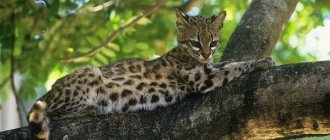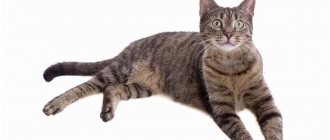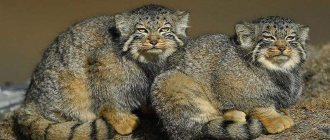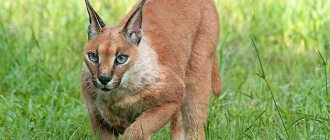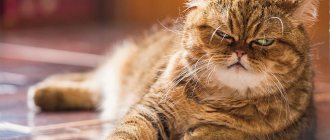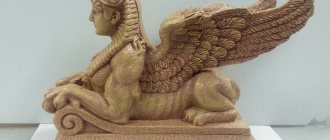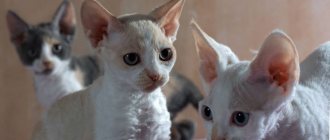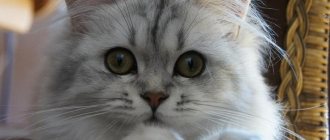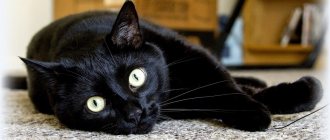What will you learn from the article?
- List of the most dangerous cat breeds
- Siamese cat
- Siberian cat
- British cat
- Maine Coon
- Mekong Bobtail
- Abyssinian cat
- Savannah
- Bengal cat
- jungle cat
- Manul
Everyone who is going to have a cat at home wants to know about the character traits of the chosen pet. In this article we will talk about those dangerous and evil cat breeds that only the most fearless owner can get along with.
Chausie
Aggressive jungle cats took part in the selection of this breed. Representatives of the reeds have never been distinguished by a calm character, and they passed this heritage on to their descendants Chausi.
“Wild” blood makes itself felt in the character of any cat of this breed. But the aggressive nature of these cats can be curbed with proper, strict education. You need to give your kitten enough attention from an early age, and then he will grow into a well-mannered pet.
But if the owner does not have time to communicate with his pet, then baby Chausie will grow into a naughty cat who is capable of doing completely unthinkable things. The owner can expect not only scratched hands, but also a house turned upside down.
Manul
Manul is one of those breeds that cannot be tamed. These cats are too freedom-loving and will never obey a person.
It is worth noting that the disobedience of the Pallas cat is primarily due to the fact that he is not a domestic cat, but a wild one. That is, these cats feel very comfortable living in natural conditions, but they are not adapted to living side by side with humans.
As soon as the manul senses danger, he will immediately attack the person. Its claws are considered very powerful by feline standards, and its fangs are 3 times longer than those of an ordinary cat. It is worth noting that Pallas cats not only behave aggressively, but also look quite menacing.
Rexes are a group of curly-haired cat breeds
Despite the common name (“rex” means “king”!), each of the breeds described below arose and developed independently, in different regions, and the ancestors were different animals. In general, curly hair is a mutation that initially arose spontaneously. As a result of systematic crossings, it was possible to consolidate this trait, and now there are curly-haired cats with different external features.
Selkirk Rex
These are the most adorable creatures, which their owners call “lambs,” “lambs,” and “poodles.”
The Selkirk's coat is quite long and thick (with wavy hairs). The history of this breed began in 1987 in the USA, with one curly-haired kitten. In order to consolidate the unusual properties of wool, Selkirks were bred (and are still knitted, because it is believed that the complete formation of the breed has not yet occurred) with exotics, Persians and British shorthair cats.
Therefore, the breed is characterized by a stocky body, a wide head, thick paws, and wide-set round eyes. Almost any color. Coat length is medium to long.
Selkirk Rex
The severity of curls can also be different - it depends on the color, time of year, even on the age of the cat (it is believed that up to 2 years of age, curliness can change - for example, kittens born with curly hair can become smooth-haired a couple of days after birth and return the curls to several months old).
By nature, Selkirks are very sociable, love to spend time with people (including children), and get along well with other cats in the same home.
A wonderful feature is that lamb cats love to purr!
Cornish Rex
Short-haired breed of curly cats. It is considered an “old” and fully formed breed - the history of the breed began in 1950 (then the first curly-haired kitten, the founder of the breed, was born in the British county of Cornwall), and in 1967 the breed was already officially registered. The name of the breed, actually “Rex”, was borrowed from the breed of rabbits of the same name, because The first curly cat was born on a rabbit farm.
Cornish Rex
To form the breed, Cornish cats were crossed with Siamese and domestic cats. The result is an elegant cat with a “dry” graceful body, an elongated muzzle, large ears, a long tail and paws. The silhouette of the Cornish Rex vaguely resembles a sphinx, only covered with fur.
And the Cornish's coat is absolutely amazing - it consists of only undercoat without guard hairs: with its waviness, it looks like the softest astrakhan fur!
The Cornish Rex really needs communication with a person - it is suitable for a family or for a person who agrees to devote a lot of time to the cat. The Cornish is intelligent, so to speak, and very smart - cats of this breed are even trained to fetch small objects and follow commands!
Devon Rex
This breed also originated in Britain in the 1960s, but, as research has proven, it is completely independent from the Cornish Rex (the mutation gene for curly hair is different, so when crossing a Devon and a Cornish, smooth-haired kittens will be obtained!). The body composition of the Devons is graceful, and the head is very unusual - flat, with wide-set large ears, large slightly slanted eyes and a slightly “snub” nose!
Devon Rex
The wool is soft because... There are few guard hairs. By the way, it is believed that Devons and Cornishes are the breeds that have the least impact on people with allergies to cats (although it is still impossible to talk about complete hypoallergenicity).
These cats are very smart and trainable. They are active and love to climb and jump! But they need to be protected from drafts and hypothermia - this breed of curly-haired cats is for a city apartment!
Ural rex
A curly-haired breed that originated independently in Russia, it is perhaps the oldest of all the world's populations of cats with wavy fur! Once upon a time, even before the war, curly-haired cats were quite common in the Sverdlovsk region, as old-timers recall. However, the local population unknowingly mistook the kittens born almost bald as sick and destroyed them, so the naturally existing breed disappeared...
And the “rebirth” of Ural curly cats began in the 80s, when an ordinary domestic cat gave birth to curly kittens, which were noticed by felinologists.
Ural rex
The Ural Rex is a strong, muscular, medium-sized cat. The eyes are almond-shaped. The muzzle and ears are of a “classic” shape. The coat is short to medium length, tightly curled, soft and very dense. Ural rexes definitely need to be combed, otherwise it will be difficult for the animal to shed itself, and this will affect the formation of curly fur!
"Urals" are cheerful and love to play with people.
The ugliest cat breeds in the world
Breeders are always striving to develop new breeds of animals. In the second half of the twentieth century, as a result of numerous experiments, the most unusual types of cats began to appear.
Sphinx
The debutant in the list of the ugliest cats is the hairless Canadian Sphynx. In 1966, a hairless male kitten was born to a black and white domestic shorthair cat in Canada. They named him Prune. When the cat reached puberty, it was mated with its mother cat, because the researchers had no other suitable specimens for breeding. There was one hairless kitten in the litter, and later there were other kittens without hair. Thus began the history of the breed, which was registered in international organizations as the “Canadian Sphynx”.
The formation of this species was not without difficulties - the coat mutation gene and closely related inbreeding led to infertility in cats and the development of hereditary pathologies. But the breeders were lucky - a second pedigree line was found in the USA. Only 20 years later (1985) the terrible Canadian Sphynxes were fully recognized as a separate breed and topped the list of the ugliest cats of their time.
It was at this time (1986) that the history of Russian sphinxes began. In Rostov-on-Don, a girl picked up a mongrel kitten on the street. Later, Varvara (that’s the name of the cat) began to actively lose hair. They tried to treat the animal, but nothing helped - the back remained bald, while the cat was completely healthy. The kittens that were born to this cat inherited unusual hair from their mother. Felinologists from other cities showed interest in them, and in 1996 they were officially recognized and added to the collection of frighteningly scary cats.
Levkoy
Levkoy can be considered a designer breed. The parents of this unusual cat were Don hairless sphinxes and Scottish fold cats. From the former, the ugly kittens inherited the absence of fur, and the latter passed on to their descendants the curved tips of their ears.
Likoy
Next on the TOP list of varieties of unusual cat breeds is the Lika. In this case, we are talking about a natural genetic change in the coat of ordinary domestic cats. This phenomenon was first noticed in the United States in 2010. Just 2 years later, scary cats with a genetic mutation were separated into a fairly large group and shown to experts. An appropriate breed standard was developed for them, and the first Lykoi were recognized by some felinological organizations.
Munchkin and minskin
The interest of breeders in unusual breeds brought leaders to the TOP, although they did not immediately fall into the category of scary ones. Until the mid-80s, cats with short legs were of almost no interest to felinologists.
Later, lovers from the USA paid attention to unusual animals and started breeding munchkins.
The mutation turned out to be natural - it was caused by a dominant gene. There was no threat to health, although at first munchkins caused heated debate among experts and doubts about their viability. But by 1995, the unhealthy criticism stopped, the terrible breed was registered and began to be popularized. Despite this, munchkins and minskins are still considered rare, exotic species of cats.
Devon Rex
The review ends with a breed that can also confidently be classified as scary cats. The first Devonian was found in England in the 60s. It differed from ordinary cats in its soft curly fur, slightly flattened head shape, large eyes and large ears. Since ten years earlier, a similar breed of Cornish Rex had already appeared in the same Great Britain, the newcomer was considered its representative. Later, a number of differences were identified and the found cat was registered as a separate species.
Asian miracle
And this is the Mekong Bobtail. Graceful creatures with the appearance of a Siamese and a short tail. The breed was approved relatively recently, in 2004. Such a short lifespan does not prevent them from gaining wild popularity among cat lovers.
Mekong Bobtails are distinguished by their grace and beauty. Their character is such that the owners cannot decide: is it a “dog cat” or a “cat dog”. The cute creatures will be happy to bring a small fetch to the owner and are not averse to going for a walk on a leash.
Asian individuals also have negative sides. It is no coincidence that they were included in the list of the most evil among felines. Bobtails do not scratch, but will bite with their teeth if necessary. Or if they feel they have been treated inappropriately. And handsome aristocrats will definitely find reasons for this.
Making a new friend
The undoubted advantage of outbred cats is that no costs are required to purchase them. Usually such pets are acquired through friends or through an advertisement. Often, stray kittens are picked up on the street. If an animal is taken from home and there is a choice, in order not to make a mistake with the character and health of the kitten, you need to take a closer look at the following signs:
- the kitten readily approaches you, tries to flirt and does not try to show aggressiveness;
- the kitten is distinguished by its external attractiveness, meekness, agility, playfulness, playfulness and does not look sad, dejected or apathetic;
- holds his head up normally and walks or runs with absolutely no limp;
- does not twitch his head, does not have a runny nose, cough, or other external painful signs;
- the kitten's skin looks clean and healthy, without irritation, dirt, scabs or flea excrement;
- the animal's coat is shiny and clean, without bald spots or tangles (matted);
- no liquid or other discharge from the eyes, nose and ears;
- the third eyelid (the so-called nictitating membrane) does not cover part of the eye;
- teeth look clean and free of tartar, there is no unpleasant odor from the mouth;
- The gums of a healthy kitten are pink and there are no signs of bleeding;
- the stomach feels quite strong and at the same time not bloated;
- the anus is clean, without remains of feces, there are no visible signs of diarrhea or worm segments (they, if present, come out of the anus and look like grains of rice).
It is recommended to wean a kitten from its mother no earlier than 2.5–3 months. At this age, the baby will tolerate separation without consequences for the psyche. He is already accustomed to the tray and “adult” food.
The offspring of outbred cats can be of a wide variety of colors
Ukrainian Levkoy – the superiority and grace of the breed borders on bright flashes of aggression
A characteristic feature of the Ukrainian Levkoy is an elongated, slightly flattened head, huge slanting eyes of soft blue or bright green. She has elegance and graceful curves of her body. The body is quite strong without hair.
The cat has high intellectual abilities. However, for all her devotion to her owner, she is very decisive and in times of danger can show aggression.
We offer you an article about the graceful but independent cat breed, the Ukrainian Levkoy.
Top 10 Smart Cat Breeds
Does your cat bring you slippers and a fresh newspaper in the morning? No? Perhaps she knows the commands “Sit” and “Face”? Not again? Congratulations, you've got an amazingly smart animal. Because the smartest cats don’t exchange their IQ for such trifles.
The cat's intelligence manifests itself in other ways. Her task is to communicate and decorate. But even knowing which cats are the most affectionate and intelligent, all the same, among them there will be record holders - not just smart cats, but the most brainy ones!
By the way, felinologists have been assuring us for decades that the older the breed, the more intelligence its representatives demonstrate. This is why it was believed for a long time that Oriental cat breeds = smart cat breeds.
But in the 21st century, it was the oriental breeds that had to make room in the Top 10 smartest cat breeds.
Mekong Bobtail
The viciousness of these cats does not apply to everyone. They are incredibly loyal to their owner and behave affectionately and friendly with him. The animal is capable of showing aggression towards strangers. It intuitively senses danger or malice and tries with all its might to prevent this from happening in the house where it lives. The cat prefers to use its teeth to fight the enemy.
Mekong Bobtails resemble dogs in their guarding qualities. What makes them similar is their love for walking on a leash and good ability to learn commands.
Mekong Bobtails are patient and friendly with children and willing to play. The animal does not tolerate long absences from its owner, although it calmly remains at home alone during the day.
An interesting feature of the Mekong Bobtail is matriarchy. If there is a couple of this breed, then the cat usually takes care of the kittens, and the cat takes the dominant position. Even with its smaller size, it is capable of chasing and offending the male.
Detailed description of the Mekong Bobtail breed »
Features of aggression
The manifestation of aggression depends on the specific situation and the animal itself:
aggression towards the owner. This behavior may only occur when the kitten has recently been adopted into a new home. The angry cat is trying to understand where he was taken from his mother and what they actually want from him. Therefore, for the first few months, until the animal gets used to the owner, such behavior can be considered normal, if it is within reason. Adult animals can also show aggression towards the owner, sometimes due to the behavior of the owner himself, and sometimes due to character or some problems. This may be snorting, hissing, or causing damage (scratches, bites). Damage to property can also be a manifestation of aggression towards owners. For example, the cat, out of the blue, tore the sofa, slippers, clothes, curtains, although he had never done this before;
An angry cat can frighten a child and cause injury
aggression towards other animals. An angry cat can be this way towards other pets, but at the same time not show such behavior around the owner. Most often, such relationships occur between cats and dogs; conflicts occur between them, as well as between two cats. An angry cat will try in every possible way to harm another pet: take away his food, toys, hit him with his paw or scratch him. The main thing that the owner should do is to understand whether this is really aggression. If a cat defends itself from the attacks of another animal, then such behavior cannot be regarded as aggression, but if there is no reason on the part of the other animal, then it is necessary to immediately limit their contact until the aggressive behavior can be dealt with; aggression towards other people. In this case, it often manifests itself due to jealousy. For example, a child appeared in the family, or the other half moved to live with the owner, or someone came to visit
Then the attention of the owners is paid to other people, and the cat evaluates these people as competitors, therefore, the attitude towards them will not be the best.
Kittens most often show aggression by biting.
Whispers of the past
Manul is a rarity among evil cats. Why? Because this predator is quite rare. It is listed in the Red Book, but practically does not live in captivity. More precisely, it exists quietly in the zoo. But in the form of a domestic cat... The owner will have to come to terms with the unpredictable temperament of the handsome cat. In response to affection, he is capable of causing injury. While maintaining wild habits, the Pallas's cat can easily turn a cozy apartment into a “caravanserai.” Everything will be torn, broken and scratched.
Possible causes of cat aggression
By nature, absolutely all cats are predators; accordingly, each breed is characterized by one or another degree of aggressiveness. Experts explain these outbursts of aggression in different ways.
However, the three main signs of bitterness are:
- pain;
- fright;
- fight for territory.
It is impossible to say unequivocally which is the most evil cat breed that comes out on top in its manifestation, but the above presented top varieties of the cat family allows us to understand their natural essence.
You can often hear the question from cat owners: “Why is my cat so aggressive? After all, I nurturing her, giving her care and affection, I don’t offend her, but she strives to bite as soon as I decide to reach out to stroke her.”
Cats can be aggressive for a variety of reasons.
There are many reasons for this manifestation of character. One of them is the taming of an adult taken from the street. In conditions of survival, cats become more wild and it is difficult for them to trust their new owner unconditionally. Another reason for aggressive behavior may be a stressful situation or forced contact with a person. If an animal allows itself to be held, this does not mean that it is not under stress.
An important factor in identifying the causes of aggressive behavior is the physiological characteristics of the character of a particular breed. You can either put up with unexpected outbursts of aggression or exclude the option of purchasing a feline pet. And yet, whatever you say, a significant point in the behavioral aspect is providing due attention and patience to raising a cat from a young age.
Bengal
Another representative of the evil cat family is the Bengal, with a pronounced hunting instinct and incredibly impressive appearance. Many of the representatives of the Bengal breed have impulsive character traits, due to which the animal becomes aggressive, capable of even attacking the owner in case of contradictions.
Raising your voice, much less shouting, is not tolerated. Day after day, Bengals tirelessly drive everywhere, and this continues until old age. Not everyone will like this. If the owner does not want to get a pet that will constantly attack him, he needs maximum attention, affection and care for the representatives of the breed.
Top 10 most evil cat breeds
Often the most evil cat breeds have an unremarkable appearance. They look pleasant, calm and peaceful, but if they suddenly feel danger, they turn into a wild animal and can cause serious harm to the health of their potential offender. In total, we can identify 10 of the most evil cats in the whole world; they can be easily recognized from photographs.
Cat in aggression
English Shorthair
The English cat has another name - British or Briton. This is a pet with an unusual face and beautiful fur, which gets along well in the same room with people. But he does not feel any affection for his owner and does not require affection from him. For this animal, its personal space is of great importance. If a person tries to pick it up or stroke it, it may bite or scratch it.
Savannah
In appearance, this evil cat looks like a small tiger cub. She has the same spotted color, serious look and impressive size. Once the savannah gets used to the owner, she will treat him good-naturedly, and occasionally she may even play with him. But such a pet is seriously afraid of strangers, and may even suddenly attack guests at home or passers-by on the street.
Note! Savannah cats are often walked on a leash, as they can pose a serious threat to people.
Savannah cat
Bengal cats
Another evil cat is the Bengal breed, which contains the blood of a wild animal. At home, a cat can be affectionate, spend time serenely and play with its owner. But you won’t be able to train her; a Bengal cat will never be able to train if she doesn’t like it. And if she feels even a slight danger from a person, she can attack and cause serious harm to his health.
Manul
The most evil cats include the Pallas cat breed. This is an absolutely wild animal that cannot be trained and cannot be forced to live in an apartment or private house with people. By its nature, it is accustomed to living on the street and will never obey a person. Catching a pet in order to put it in a cage or bring it into an apartment is extremely difficult. He can attack a person.
Note! Pallas' cat's fangs are 3 times longer than those of similar individuals, so damage from bites can be very serious
Abyssinian
The Abyssinian breed cannot be called a domestic animal either. She has a rather aggressive appearance, which is why people often feel apprehensive. The character matches the appearance. Such an individual gets along well with the owners, but if a stranger comes into the house, she will not like it and may start hunting for him, and if the opportunity arises, even bite or scratch him.
Siamese
The Siamese is also included in the ranking of the most evil cat breeds. This breed gets along well with people only if it sees a decent attitude towards itself, then it will be very playful and affectionate. The Siamese individual is distinguished by high intelligence and good memory.
Note! Once you offend a Siamese cat, she will remember it for a long time and may even begin to take revenge.
jungle cat
Many people dream of owning and training a reed cat because of its unusual color and charming tufts on its ears. But those who decide on such an undertaking almost immediately release it onto the street or give it to a nursery. This is due to the fact that this breed is absolutely wild; it is characterized by a predatory character, which is often very unpredictable. In addition, the animal is distinguished by its impressive size and endowed with powerful strength. Even a jungle cat kitten can cause irreparable harm to human health.
jungle cat
Chausie
Another cat with an angry face is the Chausie breed. It has wild roots, so it has an aggressive and disobedient character. If you try to move your pet into the house, it can quickly cause damage to the table and chairs in the kitchen, room furniture, and try to chew through wires and cables. The animal will see its enemy in the face of a person, and at the first opportunity it will attack him.
Cosmo recommends
3 effective ways to epilate legs at home
The Pallas's cat is secretive, independent, and even has fangs 3 times larger than those of ordinary cats. Although people have tamed Pallas' cats, you should be more careful with them.
A post shared by Nika Zubra ( @nika_zubra) on Mar 29, 2021 at 12:13pm PDT
A Savannah cat is literally a smaller copy of a serval (although still very large). It is not adults who are dangerous, but young individuals who attack strangers.
Britons are a popular breed of domestic cat. What is she doing in this top? These teddy bear-like animals hate being cuddled.
A post shared by Anna ( @afi_emerald) on Jun 21, 2021 at 12:14am PDT
Chausie is a cross between a domestic cat and a wild swamp lynx. Small apartments are not suitable for these cats, but if you give them a lot of space and raise them from childhood, you can achieve some degree of obedience.
A post shared by Caracat (caracat) ( @prestige_caracat) on Jun 16, 2021 at 3:07am PDT
The jungle cat is wild, although not the largest (weighs about 15 kg). The beauty with tassels on her ears really doesn’t like being petted.
A post shared by Catherine ( @madam_krushon) on Mar 10, 2021 at 6:37am PST
The fluffy Maine Coon is lazy and generally kind, but if you pester him too much, he will definitely take revenge. Therefore, the myth that these are the best friends for children is, alas, just a myth.
A post shared by Natalia Wunder ( Kulichenko) ( @little_buddha108) on Jun 21, 2021 at 12:22am PDT
But the Abyssinian cat takes revenge literally immediately.
A post shared by Masha Maas • Photographer ( @masha.maas) on Jun 20, 2021 at 11:46pm PDT
The Stone Cougar is the result of crossing a domestic cat and a jungle cat. Large, capricious and recognizes only its owner.
The appearance of the Mekong Bobtail should alert everyone, because they resemble Siamese cats, their close relatives. Alas, they are recommended to be kept as security.
Well, the most evil cat is the Siamese. This fact is even depicted in children's cartoons. Well, who is always the villain?
Videos about cats (albeit the most dangerous ones) are #3 on the “Trending” tab of YouTube. Watch in full on the Bubble channel:
Strike a pose: what techniques do stars use to look cool in photos?
Dangerous domestic cats
Usually cats are seen as cute creatures that create a certain comfort in the house. However, the fluffy face in the photo may turn out to be an aggressive cat in real life. Before welcoming a new member into the family, you should study those dangerous breeds of cats that are capable of showing cruelty towards humans.
Siamese cat
A vindictive representative of his family. The Siamese breed is famous for having one of the most vicious morals in the world, despite its delightful coloring and mesmerizing blue eyes. They can harbor a grudge against their offender for a long time and attack him at the most unexpected moment. The Siamese cat is very dangerous for small children, who, due to their lack of awareness, can offend him.
Maine Coon
The cat is a large breed with a wide chest and a massive body. His weight can reach 15 kg without obesity. Maine Coons are not safe for people. Due to their size, they are capable of crippling their owner or strangers. Cats are very smart and flexible, they do not like to be left alone. For the slightest human offense, a dangerous animal can take revenge, as they have a very changeable temperament.
shutterstock
British breed
The British are proud cats with a wayward character. Due to their independence, they do not like strangers and allow themselves to be petted very rarely. To achieve a friendly relationship with a cat, you will have to spend a lot of time on it and communicate with it often.
Abyssinians
A vengeful animal with thick fur. They do not like to sit on their owner's lap for a long time. Cats prefer to sit in high places where they are difficult to reach. Abyssinians are very vindictive, so it takes a lot of time to train them. You should mentally prepare yourself for scratches and bites, without which not a single game can be played.
Siberian cats
An independent disposition, a fluffy face and a large body - this is a Siberian breed. These cats can only make friends with a self-respecting person. In addition to aggression, the pet is able to show affection towards the owner. They get along well with other animals, but they react warily to strangers.
shutterstock
Bengal cats
The Bengal breed is a domestic cat with an impulsive character. He has a well-developed hunter's instinct. To avoid an aggressive disposition, Bengals should be raised with love and affection from childhood, and the kitten should be given a lot of attention. In moments of aggression, adults are capable of causing serious injuries to humans. Bengal cats are very active. They do not tolerate sitting on their hands or raised tones addressed to them.
Chausie
The Chausie is a predator that is very similar to the puma. His body is much more powerful than other domestic breeds. The cat is ready to hunt at any time. His aggressive behavior needs to be stopped from childhood. Spacious properties in private homes are better suited for keeping chausies. They enjoy heights and constant exercise.
Reed breed
Jungle cats are practically impossible to train. These are true predators. They are distinguished by their active and at the same time lazy character. If you managed to domesticate a cat, you will need to communicate with him a lot. Otherwise the animal will go wild again.
Manul
Almost the most aggressive cat is the Savannah. This slender cat with a small head has a beautiful leopard print color and pointed ears.
shutterstock
The cat is aggressive, but it can still be tamed. A domesticated savannah dog on a leash accompanies its owner. When walking, you should especially closely monitor the animal, since it can react to a stranger as if it were prey.
Savannah
The Pallas's cat is almost impossible to train. The kitten is gloomy and indomitable. He will not be affectionate, playful and homely. In the house the manul will be unsociable and uncontrollable. An untamed cat will very quickly create chaos and disorder in the house.
Cats are predators by nature. Most of them, even after many years of domestication, can show sudden aggression. Most often, the cause of anger is pain, struggle for the owner or territory, and fear.
https://youtube.com/watch?v=mjzW3—oBiE
Maine Coon
Representatives of this breed delight people with their stern appearance and massive body. In size, they are almost twice the size of ordinary cats.
They are distinguished not only by their beautiful and unusual appearance, but also by their flexible mind and high intelligence.
Maine Coons by their nature are real phlegmatic people. They are quite calm and confident. However, if you raise a Maine Coon incorrectly, you can end up with frequent hissing and attempts by the cat to bite or scratch not only strangers, but also its own owner.
However, you should not think that aggressive individuals are common among Maine Coons. Rather, the aggression of this breed is the result of improper upbringing or lack of proper attention of the owner to the cat person.
TOP 10 most evil dog breeds on the planet
There are the most evil breeds of dogs that, if not properly trained, can cause harm to other people, their own brothers and even their owners:
- Cane Corso. The Vicious Dog is a descendant of the fighting dogs of Ancient Rome. The breed is muscular, strong and hardy, requiring constant physical and mental activity. As a rule, dogs choose one owner and demand attention from him. Without receiving it, they can become aggressive and withdrawn. Horse Corso will become good defenders of the home, since they consider the territory of the owner and his family to be their property;
- American Bandog. The breed was originally bred to participate in battles. Currently banned in some countries, as the dogs are extremely active and merciless. Living in apartments is not suitable for them. The best solution is a private house with a spacious enclosure. The dog requires daily training and activity to release energy and reduce aggressiveness;
- Neapolitan Mastiff. A large dog weighing up to 90 kg is considered one of the best watchdogs. Previously, the breed was used in Ancient Rome as a fighting dog. The dog itself is quite balanced, but requires balanced training;
- Staffordshire Terrier. Bulldog and terrier mix. Dogs took part in battles in England in the 19th century. Distinctive features are strength, courage, endurance. Moreover, representatives of this breed are devoted assistants to their owner. They require daily training. Dogs with proper upbringing do not show unreasonable aggression, but will always protect their owners in case of danger;
- rottweiler The breed was bred in Germany. The dog is a born fighter and protector. Quite an angry dog, aggressive towards strangers, even children. The dog chooses one owner, loves a calm atmosphere in the house, therefore, with frequent domestic conflicts, it can become aggressive towards the owners;
Rottweiler
- German Shepherd. The dog is friendly towards members of the household, but vicious towards strangers. Most often they are brought into private houses to protect the territory. The “German” is smart, easy to train, but requires attention, so it is necessary to teach discipline from an early age;
- Dogo Canario Quite a powerful and strong breed from Spain. He is a good protector for his owners in any situation. Previously, it was bred to guard livestock and fight dogs. The Dogo Canary is capable of independently making informed decisions and is merciless when a threat to its owner arises. In some countries the breed is banned as there have been cases of attacks on its owners;
- American Pit Bull Terrier. Dangerous, aggressive dogs, but with proper training they are quite manageable. They can become “cold weapons” in the hands of their owners, which is why in some countries owners of pit bulls are required to undergo psychological tests before getting a pet of this breed;
- South African Boerboel. An experienced owner is needed to teach the dog obedience, as dogs of this breed tend to dominate. A reliable defender, he quickly develops speed and will not give the enemy a chance to escape. There are known cases of attacks on people; in some countries the breed is prohibited for home breeding;
- Hungarian Kuvasz. The dogs come from Hungary and were intended to protect pastures, so they are genetically endowed with the necessary qualities to protect the owner and his family.
Important! The willful nature makes it difficult to train the Kuvasz, so patience and consistency will be required. Only in this case will Kuvasz become a reliable protector and devoted friend
Ethiopia here
The Abyssinian cat was not spared. This is one of the most ancient breeds. Its representatives lived in the territory of Ethiopia (formerly Abyssinia) already two thousand years ago. They were depicted next to the pharaohs. Such a high proximity did not affect the character of the cats. They do not have royal manners and behavior at all. Abyssinians are active and love to climb trees. They are attracted to heights. Curious and observant. In these 4 kg bodies beats the heart of a researcher. This breed will not let its owner get bored. But if he treats the pet without due respect, the cute cat is quite capable of explaining his ignorance to the owner. And the Abyssinian will use her own methods for this - cat methods. Claws and teeth will help her.
